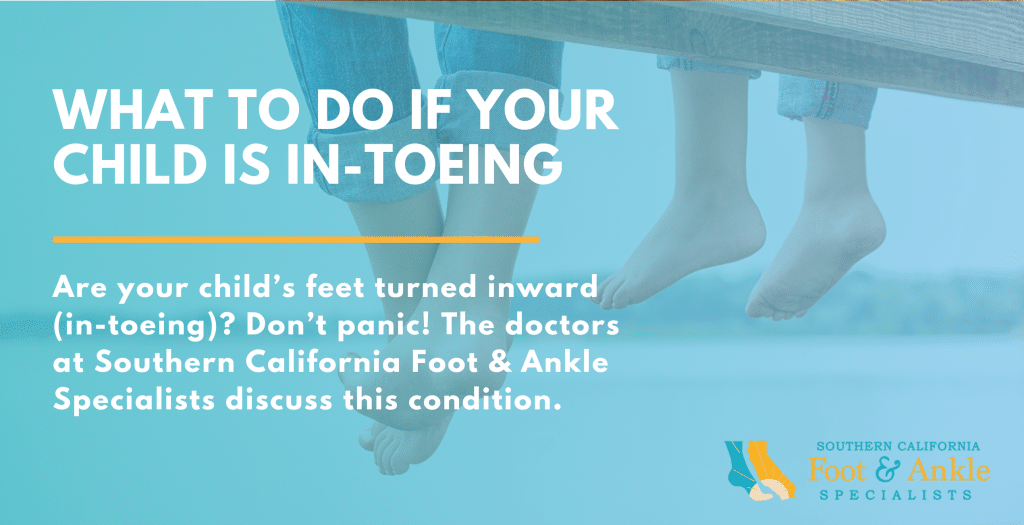What to Do If Your Child is In-toeing
As a parent, you want to ensure the path for your child is as clear and free of obstacles as possible. So when you see a potential problem with your child’s physical development, it is only natural to take it with a hefty degree of concern.
If you notice the front of your child’s feet are turned inward, it can certainly raise some red flags. The need to find out as much as you can about what’s going on may be why you stumbled across this blog in the first place!
If your child’s feet curve inward, it may be a condition known as metatarsus adductus—which we will be providing further information about here.
Whatever the cause may be, however, rest assured that Southern California Foot & Ankle Specialists is committed to getting to the root of all children’s foot and ankle problems in a way that best benefits the child and best puts parents’ minds at ease. And in many cases of foot abnormalities such as this, a resolution happens very easily.

What is Metatarsus Adductus?
As young feet develop, they sometimes exhibit symptoms of deformity. In the case of metatarsus adductus, an inward “bend” is visible in the middle of the foot while the heels and rear of the foot remain in normal alignment. Other symptoms may include:
- The toes pointing inward.
- A small “gap” between the largest and second-largest toes.
- The front of the foot being turned slightly downward.
- A more rounded appearance to the outside of the foot.
About 1 in 1,000 live births exhibit signs of metatarsus adductus, and it appears to be more common in firstborn children. About half of all children with metatarsus adductus show symptoms in both feet.
What is Responsible for Metatarsus Adductus?
There is currently no known cause for metatarsus adductus. There is a theory that the condition may develop as a result of the fetus being tightly packed within the uterus in a certain position during development, but this is not confirmed.
One thing is for certain, however: You as a parent did not do anything wrong for this condition to develop. You are not to blame, and there is nothing you could have done to prevent it.
What Does This All Mean for My Child?
The best news about metatarsus adductus is that it often requires no treatment at all. When the condition is flexible, the abnormality in your child’s foot shape will slowly and naturally correct itself as your child’s feet grow and develop. Correction is usually completed around 1-2 years of age.
However, this in no way means your child’s condition should not be monitored or receive any attention.
First, we should diagnose the severity of the condition by testing the range of motion in your child’s feet. If the foot can still be straightened with gentle manual pressure, it is considered “flexible” and is still very likely to resolve on its own. However, if the foot can’t be straightened with gentle pressure, it is considered “non flexible” and more advanced treatment may be necessary. An examination might include an X-ray, but one is not always necessary.
If your child’s condition is flexible, that is certainly good news. Though it should still be regularly monitored over time to ensure that your child’s development is progressing well and that the condition is not becoming more rigid.
If we catch a developing problem and begin treatment early, it tends to be an overall much faster and easier experience to resolve. If, on the other hand, metatarsus adductus is left untreated into maturity, it becomes much more difficult to treat and can lead to additional complications. These can include ankle instability, hip pain, bunions, and other problems.
How is Metatarsus Adductus Treated?
Treatment for metatarsus adductus will largely depend on the severity of the condition, your child’s age, their medical history, and other factors.
If your child does require treatment, please know that success rates are extremely high. Most children who receive treatment will reach adulthood with no signs of metatarsus adductus and no significant problems or consequences as a result.
A comprehensive treatment plan will be developed for your child, and may include:
- Foot and leg casting to gently guide the foot or feet back to a standard position. New casts will be applied every one to two weeks for a period of time. This should ideally begin before the age of one, and can be considered similar to braces for the straightening of teeth.
- Splints or special shoes that are made to hold the feet in proper alignment.
- Stretching exercises to help strengthen supporting muscles and build range of motion in the feet. This may involve passively manipulating your child’s feet during parts of the day, such as diaper changes.
The potential need for surgery may exist, but only in rare situations. Surgical procedures tend to be reserved more for older children (4 years or over). They may involve cutting certain bones of the foot and fixing them straight with plates and screws. If surgery is a consideration in your child’s case, we will fully discuss everything you would need to know before, during, and after a procedure so you can make a decision with full knowledge and the best interests of your child in mind.

Setting a Straight Path to the Future
If your child shows signs of metatarsus adductus or in-toeing, don’t despair. We can keep a watchful eye on your child’s development and take action if necessary to ensure it does not become a chronic problem in their future. We are also experts in diagnosing and treating a variety of other childhood foot deformities as well—all with the same attentive care and compassion.
Call our Ladera Ranch office at (949) 364-9255 (WALK) to schedule an appointment with us. If you prefer to reach us electronically, please feel free to fill out our online contact form instead.
Sources
https://www.hopkinsmedicine.org/health/conditions-and-diseases/metatarsus-adductus
https://www.chop.edu/conditions-diseases/metatarsus-adductus
